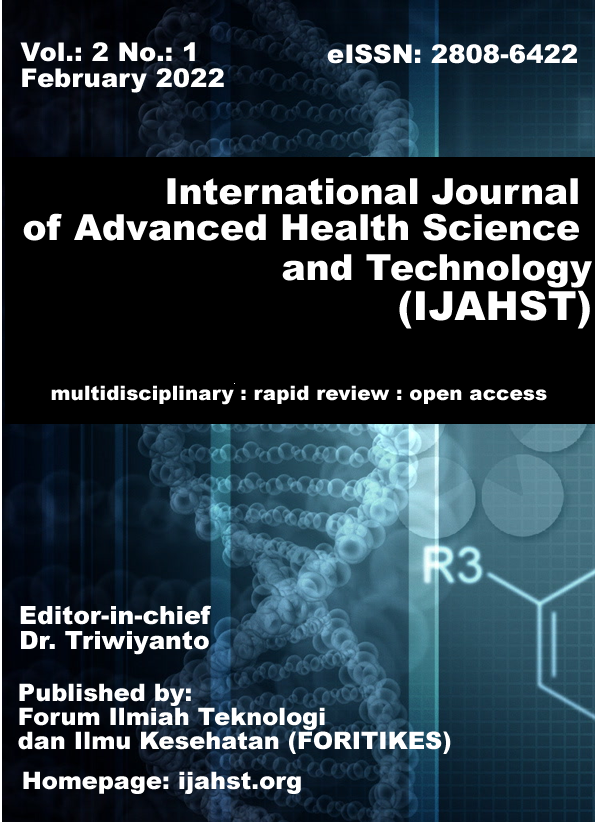Description of Platelet Count Patients Infected with Corona Virus (Covid-19) with Grouping of Productive and Elderly Age
Abstract
Routine hematology tests are one of the supporting tests in diagnostics to assess the severity of the disease and predict risk in COVID-19 patients, and can be used as supporting data on RT-PCR tests. Some blood tests that are widely used as monitoring tools and predicators of COVID-19 are the number of leukocytes, the number of lymphocytes, the number of neutrophils, the number of platelets and NLR (Neutrophil lymphocyte ratio). Thrombocytopenia occurs due to excessive use of tromocytes in the body as compensation for damage to lung parenchym cells, the lungs are organs where platelets are released from megacaryocytes, so this damage causes disruption of platelet maturation process. The type of research used is quantitative descriptive with the aim to find out the results of blood tests complete with platelet parameters in patients infected with the COVID-19 coronavirus at Muhammad Noer Pamekasan General Hospital. The results of the study were platelet count test results at normal productive age of 67 respondents (96%) and decreased platelet count (Thrombocytopenia) by 3 respondents (4%). While in normal elderly age a number of 26 respondents (87%) and a decreased platelet count (Thrombocytopenia) amounted to 4 respondents (13%).
Full text article
References
F. Salamanna, M. Maglio, M. P. Landini, and M. Fini, “Platelet functions and activities as potential hematologic parameters related to Coronavirus Disease 2019 (Covid-19),” Platelets, vol. 31, no. 5, pp. 627–632, 2020.
H. Li, B. Wang, L. Ning, Y. Luo, and S. Xiang, “Transient appearance of EDTA dependent pseudothrombocytopenia in a patient with 2019 novel coronavirus pneumonia,” Platelets, vol. 31, no. 6, pp. 825–826, 2020.
D. Budiman and C. Chu, “A SWOT Analysis of Indonesia’s COVID-19 Pandemic Response Strategy,” Int. J. Adv. Heal. Sci. Technol., vol. 1, no. 2, pp. 50–52, 2021.
B. K. Manne et al., “Platelet gene expression and function in patients with COVID-19,” Blood, vol. 136, no. 11, pp. 1317– 1329, 2020.
A. Rampotas and S. Pavord, “Platelet aggregates, a marker of severe COVID-19 disease,” J. Clin. Pathol., vol. 74, no. 11, pp. 750–751, 2021.
G. Bomhof et al., “COVID-19-associated immune thrombocytopenia,” Br. J. Haematol., 2020.
X. Ding et al., “Dynamic profile and clinical implications of hematological parameters in hospitalized patients with coronavirus disease 2019,” Clin. Chem. Lab. Med., vol. 58, no. 8, pp. 1365–1371, 2020.
D. Wang et al., “Clinical course and outcome of 107 patients infected with the novel coronavirus, SARS-CoV-2, discharged from two hospitals in Wuhan, China,” Crit. Care, vol. 24, no. 1, pp. 1–9, 2020.
E. Güçlü et al., “Effect of COVID-19 on platelet count and its indices,” Rev. Assoc. Med. Bras., vol. 66, pp. 1122–1127, 2020.
D. Giannis, I. A. Ziogas, and P. Gianni, “Coagulation disorders in coronavirus infected patients: COVID-19, SARS-CoV-1, MERS-CoV and lessons from the past,” J. Clin. Virol., vol. 127, p. 104362, 2020.
X. Luo et al., “Prognostic value of C-reactive protein in patients with coronavirus 2019,” Clin. Infect. Dis., vol. 71, no. 16, pp. 2174–2179, 2020.
X. Bi et al., “Prediction of severe illness due to COVID-19 based on an analysis of initial Fibrinogen to Albumin Ratio and Platelet count,” Platelets, vol. 31, no. 5, pp. 674–679, 2020.
G. Lippi, M. Plebani, and B. M. Henry, “Thrombocytopenia is associated with severe coronavirus disease 2019 (COVID-19) infections: a meta-analysis,” Clin. Chim. acta, vol. 506, pp. 145– 148, 2020.
N. Ozcelik, S. Ozyurt, B. Yilmaz Kara, A. Gumus, and U. Sahin, “The value of the platelet count and platelet indices in the differentiation of COVID‐19 and influenza pneumonia,” J. Med. Virol., vol. 93, no. 4, pp. 2221–2226, 2021.
A. Amgalan and M. Othman, “Hemostatic laboratory derangements in COVID-19 with a focus on platelet count,” Platelets, vol. 31, no. 6, pp. 740–745, 2020.
X. Zhao et al., “Early decrease in blood platelet count is associated with poor prognosis in COVID-19 patients— indications for predictive, preventive, and personalized medical approach,” EPMA J., vol. 11, no. 2, p. 139, 2020.
Authors
Copyright (c) 2022 Hapipah Hapipah, Anik Handayati, Nur Vita Purwaningsih

This work is licensed under a Creative Commons Attribution-ShareAlike 4.0 International License.
Authors who publish with this journal agree to the following terms:
- Authors retain copyright and grant the journal right of first publication with the work simultaneously licensed under a Creative Commons Attribution-ShareAlikel 4.0 International (CC BY-SA 4.0) that allows others to share the work with an acknowledgement of the work's authorship and initial publication in this journal.
- Authors are able to enter into separate, additional contractual arrangements for the non-exclusive distribution of the journal's published version of the work (e.g., post it to an institutional repository or publish it in a book), with an acknowledgement of its initial publication in this journal.
- Authors are permitted and encouraged to post their work online (e.g., in institutional repositories or on their website) prior to and during the submission process, as it can lead to productive exchanges, as well as earlier and greater citation of published work (See The Effect of Open Access).

